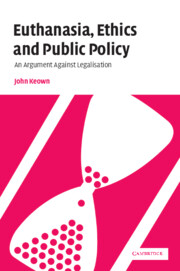Book contents
- Frontmatter
- Contents
- Preface
- Foreword
- Acknowledgments
- Table of cases
- List of abbreviations
- Introduction
- PART I Definitions
- PART II The ethical debate: human life, autonomy, legal hypocrisy, and the slippery slope
- PART III The Dutch experience: controlling VAE? condoning NVAE?
- 8 The guidelines
- 9 The first Survey: the incidence of ‘euthanasia’
- 10 Breach of the guidelines
- 11 The slide towards NVAE
- 12 The second Survey
- 13 The Dutch in denial?
- PART IV Australia and the United States
- PART V Expert opinion
- PART VI Passive euthanasia: withholding/withdrawing treatment and tube-feeding with intent to kill
- Conclusions
- Afterword
- Bibliography
- Index
11 - The slide towards NVAE
Published online by Cambridge University Press: 20 July 2009
- Frontmatter
- Contents
- Preface
- Foreword
- Acknowledgments
- Table of cases
- List of abbreviations
- Introduction
- PART I Definitions
- PART II The ethical debate: human life, autonomy, legal hypocrisy, and the slippery slope
- PART III The Dutch experience: controlling VAE? condoning NVAE?
- 8 The guidelines
- 9 The first Survey: the incidence of ‘euthanasia’
- 10 Breach of the guidelines
- 11 The slide towards NVAE
- 12 The second Survey
- 13 The Dutch in denial?
- PART IV Australia and the United States
- PART V Expert opinion
- PART VI Passive euthanasia: withholding/withdrawing treatment and tube-feeding with intent to kill
- Conclusions
- Afterword
- Bibliography
- Index
Summary
The Remmelink Report
The Survey revealed that the Dutch system of regulation had failed to prevent major non-compliance with the guidelines. Nor is this surprising: the system could never realistically hope to detect doctors who ignored the guidelines since it essentially relied on them to expose their own non-compliance. It is therefore puzzling that the Remmelink Commission should have concluded that the ‘medical actions and decision process concerning the end of life are of high quality’. No less puzzling, given the failure of a large majority of doctors to report cases, was Professor Van der Maas's observation that the Survey showed that doctors were ‘prepared to account for their decisions’.
Moreover, the Remmelink Report's narrow categories of ‘euthanasia’ and ‘intentional killing without request’ may have suggested to those who had not considered it before a neat way of side-stepping the reporting procedure. A doctor might end life not by intentionally administering a lethal drug, which the guidelines would require to be reported, but by an overdose of morphine or by withdrawing treatment, and then claim (in the most unlikely event of being challenged) that this was not ‘euthanasia’ but ‘normal medical practice’.
Even though later statistics have indicated, as we shall see in the next chapter, a significant increase in the number of cases reported (for example, 1,303 were reported in 1993), it was always likely, because of the absence of any effective independent check, that the reporting procedure would remain a wholly inadequate regulatory mechanism and that the reports filed would continue to provide a misleadingly reassuring picture.
- Type
- Chapter
- Information
- Euthanasia, Ethics and Public PolicyAn Argument Against Legalisation, pp. 115 - 124Publisher: Cambridge University PressPrint publication year: 2002

